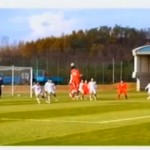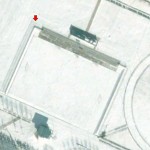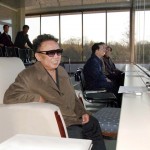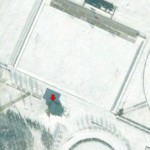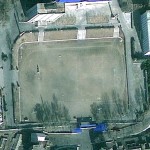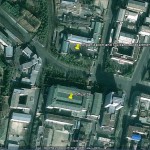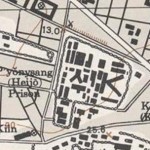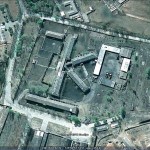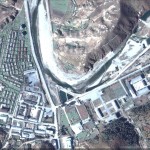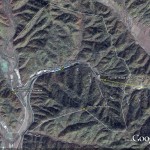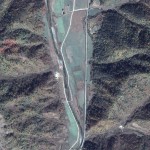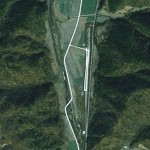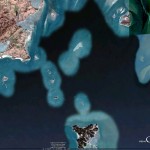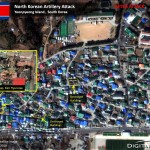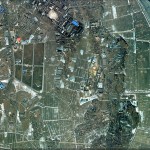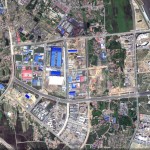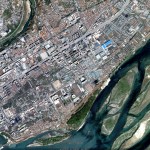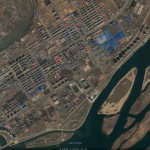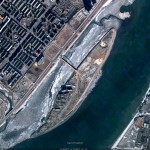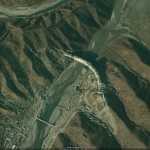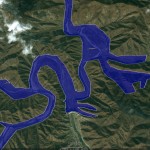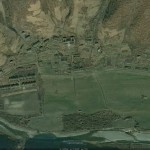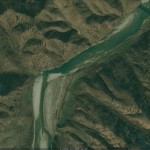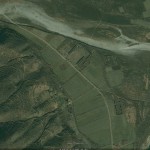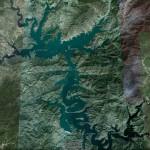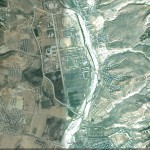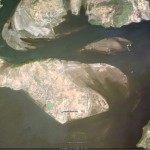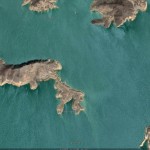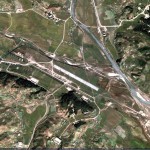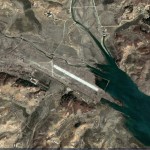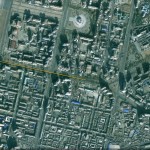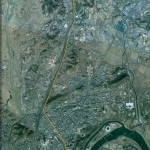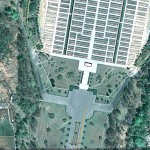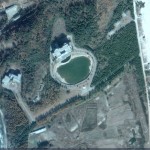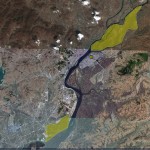As the focal point of DPRK-PRC trade, Dandong has seen phenomenal growth in the last 5 years.
Here is a separate area in northern Dandong where Yalu River high-rise development is underway:
Dandong has been the focus of increasing media attention over the last 10 years because it has economically benefitted from increased trade (and expected future trade) between the PRC and DPRK.
Today it is probably the easiest place to collect “survey data” on the DPRK’s business environment. According to a recent article in the Associated Press (via San Francisco Examiner), the DPRK still has a long way to go before foreign investors will see a climate ripe for investment:
Just across the Yalu River from North Korea, this sleepy border town in China’s Rust Belt is booming.
Towering apartment blocks are going up on the city’s western edge near the new Friendship Road Bridge, which will soon be the second bridge connecting Dandong to the North Korean city of Sinuiju.
Offices for trade and export-import companies dot the main road along the riverfront. A new airport is being built. Shops sell North Korean liquor, blueberry wine, ginseng, stamps and music CDs. And North Korean restaurants offer popular Korean dishes such as stewed dog leg and spicy deep-fried dog.
Dandong – like other parts of northeastern China along the 870-mile border – aims to profit from China and North Korea’s growing cross-border trade, now close to $3 billion a year. At a time when the United States and its allies are looking to isolate the Pyongyang regime for its nuclear program and erratic behavior, including this week’s artillery attack on a South Korean island, this hardscrabble part of China is finding that being North Korea’s back door to the world can be a lucrative business.
China already provides an estimated 90 percent of North Korea’s energy needs and most of its food and weapons. And the most recent gauge of trade between the two countries, from 2008, showed an increase of more than 40 percent from the previous year, according to the Council on Foreign Relations.
But even as officials map out grand plans for more cooperation, merchants and small-scale traders say doing business with North Korea remains problematic at best.
The government is unpredictable, they say, and rules change without warning. They tell horror stories about Chinese traders who have lost millions of dollars in goods or equipment that is expropriated or stolen outright. Many now insist on cash-up-front transactions and mostly conduct business on the Chinese side of the border, where they say they have more protections.
Moreover, while North Korean leaders have visited this part of China and professed admiration for China’s economic boom, local Chinese traders and businessmen in close contact with North Koreans say they don’t expect the country to shift to a market economy anytime soon.
“I haven’t seen any sign the North Korean government wants to open up,” said Cui Weitao, 47, who has been trading fruit, clothing, plastic bowls and chopsticks to North Korea for the past decade. “If they really wanted, they could learn from China and Russia. If they wanted, they could let people go back and forth and trade freely. . . . If they opened the border, their whole country would benefit.”
His friend, Wang Tiansheng, 47, another small-scale trader, agreed. “The thought of economic reform has been there for years but never happens. Not while the father is alive,” he said, referring to the country’s leader, Kim Jong Il. “Maybe when the son takes office.”
China and North Korea have been close allies since Chinese troops crossed the Yalu River to help North Korea fight American and South Korean troops during the Korean War, which is referred to here as the “War to Resist U.S. Aggression and Aid Korea.”
Yet Chinese leaders themselves consider North Korea’s leader an often-troublesome ally because of his brinkmanship with the United States over his country’s nuclear capability and incidents such as this week’s artillery barrage of Yeonpyeong Island, which killed two South Korean marines and two civilians, and the sinking of a South Korean warship in March.
Chinese leaders are reported to be concerned about North Korea’s economic crisis, and they encouraged Kim to embrace market-based economic reforms when he visited China in May and August this year and met with Chinese President Hu Jintao, according to some Hong Kong and South Korean media reports of the visits.
In a bow to reforms, North Korea sent a dozen mayors and provincial chiefs to northeastern China in October to visit factories and chemical plants. Earlier this month, North Korean Premier Choe Yong Rim visited Harbin, in Heilongjiang province, to discuss joint economic projects.
North Korea agreed to lease two Yalu River islands to China to develop into “free trade zones.” Chinese high-tech companies were encouraged to signed agreements to hire North Korean computer experts. In September, after Kim’s second visit, China established a new 100,000-square-foot marketplace in Tumen – across from Namyang in North Korea – for North Koreans to come on one-day passes to sell or trade their goods.
But the Tumen market in many ways illustrates the difficulties of coaxing North Korea to open up. The vast market is now mostly empty because the North Korean government changed its mind about allowing its citizens to come to China to trade freely, Tumen residents said.
One of the few Chinese vendors in the market during a recent visit, who was selling North Korean crab, shrimp and frozen fish, said he lost a lot of money because his North Korean supplier increased prices without warning.
“It’s been really hard and risky to do business with North Korea, firstly because of the complicated procedures of going there,” the seafood vendor said, speaking on the condition of anonymity. He said Chinese traders need an invitation from a state-owned company and three stamps from three departments.
Once inside North Korea, he said, officials “are very greedy. They asked us for digital cameras or DVD players or even computers. We have to buy them dinner, and booze is a must for every time we meet.”
Even the new Friendship Road Bridge being constructed – to augment the existing single-lane bridge – has been difficult to negotiate. China agreed to foot the bill for building the bridge, more than $200 million. But then North Korea demanded China also build a five-star hotel and other infrastructure on the North Korean side, local businessmen said.
Economists said the experience of the local traders confirms their own research: that while North Korean officials publicly claim to want to pursue economic reform, and may speak of emulating China’s success, North Korea’s ruling elite remains deeply ambivalent about anything that might dilute its grip.
“The state has never been comfortable with the market,” said Marcus Noland, senior researcher with the Peterson Institute for International Economics in Washington, who surveyed 300 Chinese companies operating in North Korea. “They see the market potentially as an alternative path to wealth and prestige, and perhaps political power.”
While trying to “deepen their economic integration with China” at the official level, Noland said, North Korean leaders at the same time take steps “to eradicate this kind of normal trading activity at the border” by denying visas and constantly changing the regulations.
“The Chinese do not trust the North Koreans at all,” Noland said.
I am not sure of the exact location of the new bridge. If any readers are aware, please let me know.
